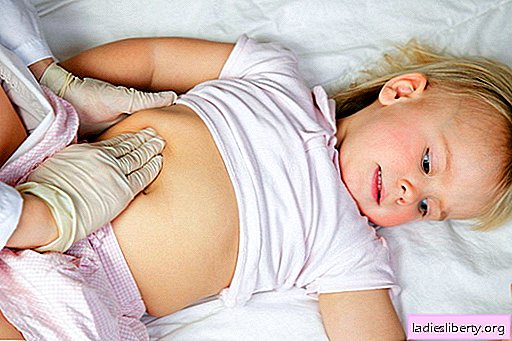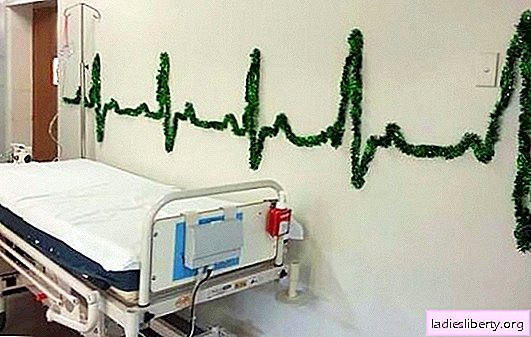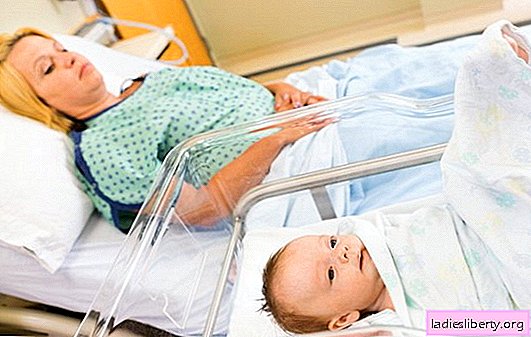
Hernia in children is a relatively common ailment. Infants, especially premature babies, can be born with this ailment, but a hernia can also occur later, in the process of development of the child.
Externally, the pathology manifests itself as a bump on the muscle of the abdomen, which bulges under the skin. The abdomen is the most common site of hernia formation, and the common types of pathology are the umbilical and inguinal.
In medical practice, diaphragmatic hernia is also found - cardiac or esophageal, but this type of pathology rarely occurs in early childhood.
An umbilical hernia is formed when parts of the abdominal organs fall under the dermis in the navel.
Inguinal hernia - when fragments go into the groin.
Who is at increased risk for hernia?
A hernia occurs if:
• there is a family propensity for the appearance of a hernia (the parents had a hernia in infancy);
• cystic fibrosis has occurred in family history;
• the baby has pronounced hip dysplasia;
• in the newborn revealed undescended testes;
• the child has anomalies in the urethra.
In infants, both umbilical and inguinal hernia are found. A hernia can occur on an ongoing basis or only at the time of physiological stress or sudden movement.
Umbilical hernia in newborns
The umbilical hernia in infants often appears after birth, almost immediately after tightening the umbilical opening and the formation of scar tissue on the navel. It arises:
• approximately 10% of infants;
• more often in children from parents of different races;
• more often in crumbs than in tots;
• more often in babies born prematurely.
If the umbilical ring is not completely compressed, fragments of organs from the abdominal cavity can penetrate the skin - a hernia is formed. Hernia in infants can reach a size: from a nut to a large plum. To the touch it is felt like a soft air ball. When pressed, it goes into the abdomen and makes a characteristic gurgling sound.
Signs and symptoms of umbilical hernia in newborns
• soft swelling around the navel;
• edematous skin at the navel (appears after the formation of a hernia);
• increased edema with bouts of crying, coughing, sneezing, tension of the abdominal muscles.
In most babies, a hernia does not require special treatment, and by 2-3, less often 4-5 years old, goes without treatment, against the background of strengthening of the abdominal walls. After the hernia is gone, it is unlikely to happen again. The likelihood of a hernia is possible against the background of an abdominal injury or surgery.
Inguinal hernia in newborns
Stretching in the navel occurs:
• approximately 1-3% of infants;
• more often in infants born prematurely;
• boys are much more likely than little girls;
• more often on the right side of the inguinal region than on the left, but can occur on both sides.
Why does a hernia in the groin of newborns occur?
Since the boy grows and develops during pregnancy, his testicles form in the abdominal cavity, which, as they grow, move down into the scrotum, through the inguinal canal.
After birth in boys, the inguinal canal closes and does not allow the testes to move into the abdomen. If the inguinal canal is not completely closed, fragments of the abdominal cavity can penetrate the canal through weak areas of the lower abdominal cavity, provoking the formation of a hernia.
Girls, although there are no testicles, have an inguinal canal that keeps the uterus in a normal state, so they can also develop an inguinal hernia.
Signs and symptoms of inguinal hernia in newborns
• visible mild swelling above the inguinal region or in the scrotum;
• swelling in the area of swelling (may appear simultaneously with the tumor, but most often forms later);
• an increase in edema at the time of crying, coughing, sneezing, muscle tension in the abdomen.
Treatment of (professional) inguinal hernia in infants
All babies who have been diagnosed with inguinal hernia need surgery because the hernia can become restrained. The operation is performed as planned, after a thorough examination of the baby and the conditions of the pathology.
However, if the hernia is very painful, creates extensive swelling and fever in the infant, an urgent operation is required. During the operation, fragments of the abdominal region are pushed back into the abdomen, and the hole or space that caused the hernia is eliminated.
During the operation, the surgeon can check the opposite part of the groin for the formation of a hernia and eliminate the pathology if it was present there. A child from a hospital can return home on the day of surgery, and be active after 5-6 days.
Hernia in older children (preschoolers and adolescents)
Hernias in this category of children occur in certain parts of the body - the abdomen, groin, thigh or navel. They can also form in any place where there was an incision after the operation. The development of a hernia can take a lot of time, but it can also develop suddenly. Hernias, as a rule, develop against the background of weakness of the muscles of the abdomen and abdominal cavity (often a congenital defect), as well as excessive muscle tension. A hernia is often painful.
In older children and adolescents, the causes of hernia can be:
• obesity or sudden weight gain;
• lifting heavy objects;
• diarrhea or constipation;
• frequent severe coughing or sneezing;
• early pregnancy.
The listed types of causes cannot cause a hernia. But when the causes combine with weak abdominal muscles, the probability of a hernia is very high.
Many hernias are detected by a doctor during a routine physical examination.
Umbilical hernia in children
A hernia in the navel in older children looks exactly like in infants, and shows the same symptoms as a lump in the navel. However, in adult children, hernias are often painful and require special treatment.
Symptoms that indicate the severity of the situation and require medical or surgical treatment:
• the child feels unbearable pain in the abdomen and navel;
• vomiting and nausea are present;
• the bulge of the hernia has become colorless or red.
Umbilical hernia in early childhood occurs when pressure is applied to too weak abdominal muscles. The condition occurs when:
• overweight;
• early pregnancy;
• fluid accumulated in the abdominal cavity;
• surgery of the stomach, abdominal organs.
Diagnosis of umbilical hernia, most often, occurs when performing a routine medical examination.
Complications associated with umbilical pathology
Umbilical hernia rarely causes complications in children. However, if it is restrained and trapped, it can give a serious aggravation.
The intestines, which cannot function normally due to pinching, receive insufficient blood circulation, can cause severe pain, tissue gangrene, and lead to a dangerous infection. In this situation, only urgent surgery can eradicate the problem.
How is umbilical hernia treated in older children?
Doctors are in no hurry to use surgery in the treatment of this type of hernia, since the pathology often disappears without treatment. The operation is prescribed in cases when a hernia:
• becomes painful;
• getting too big;
• does not decrease in size during the year;
• pinched and blocks the normal functioning of the intestine.
Hernia Surgery
The operation lasts about an hour. The doctor performs an incision in the navel at the site where the bulge is present. Pinched tissue is returned back to the stomach, and the hole is sutured. In some cases, the surgeon can strengthen the walls of the abdomen using the finest medical mesh.
After surgery
After surgery, the teenager can be discharged from the hospital after 3-4 hours. Within a week, he will be recommended a sparing regimen, without sports and active exercises. After a week, the child can return to school. A child will be allowed to take a bath with a washcloth after 14 days. Surgery rarely has complications.
Inguinal hernia in older children
In adult children, inguinal hernia is manifested by a bulge in the groin area. The bulge can appear gradually, over several days or months, or form suddenly after lifting weights, intense tension, laughter or coughing.
With a hernia, children begin to experience discomfort, overflow and pulling pain in the lower abdomen. When bending and climbing stairs - the condition worsens. In some children, the presence of a hernia may be unnoticed, since the pathology does not cause pain and discomfort.
Common symptoms of inguinal hernia in children
• sharp, severe pain, nausea and vomiting (often occurs when the intestines are pinched against a hernia);
• scrotum tumor in boys, an increase in the size of the labia - in girls;
• aching, pulling pain in the groin in boys, abating in the supine position;
• chronic pelvic pain in girls;
• a feeling of discomfort when walking.
Diagnosis of an inguinal hernia in both boys and girls is carried out by the surgeon. Patients may be prescribed irrigoscopy, herniography, ultrasound of the scrotum and inguinal canals.
Symptoms of a hernia formed in the groin can develop gradually, and also appear suddenly. Small hernias may not cause any inconvenience. Large hernias, with sliding and relapsing forms, often give pain and constant anxiety.
Inguinal hernia in children can be:
• oblique (congenital, acquired);
• direct (acquired);
• combined, have several hernial sacs communicating with each other.
Complications of inguinal hernias
• infringement, accompanied by sudden compression of hernia tissue;
• testicular inflammation;
• accumulation of feces in the intestine;
• inflammatory manifestations in the tissues of hernia.
Inguinal hernia is successfully treated with surgery. If treatment is delayed, the hernia begins to form irregular hernias and exacerbates the course of the disease.
Modern surgery offers patients several options for eliminating the ailment:
• endoscopic hernioplasty;
• Liechtenstein operation;
• obstructive hernioplasty.
The latter option is the most preferred. It allows patients not to feel pain. Allows you to leave the hospital after 3-4 hours. No complications.
Prevention of inguinal hernia in a child
The occurrence of inguinal hernia can be prevented if:
• wear a bandage belt while performing strength exercises, lifting heavy objects, with complex physical work;
• follow a proper diet;
• regularly perform physical exercises to train the abdominal muscles.
• negatively relate to smoking and smoking friends (smoking provokes a cough, which can lead to a hernia).











